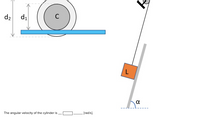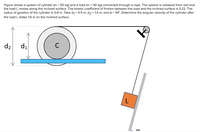
Elements Of Electromagnetics
7th Edition
ISBN: 9780190698614
Author: Sadiku, Matthew N. O.
Publisher: Oxford University Press
expand_more
expand_more
format_list_bulleted
Question

Transcribed Image Text:d2
di
a
The angular velocity of the cylinder is
[rad/s).

Transcribed Image Text:Figure shows a system of cylinder (m = 50 kg) and a load (m = 30 kg) connected through a rope. The system is released from rest and
the load L moves along the inclined surface. The kinetic coefficient of friction between the load and the inclined surface is 0.22. The
radius of gyration of the cylinder is 0.8 m. Take d1 = 0.5 m, d2 = 1.4 m, and a = 34°. Determine the angular velocity of the cylinder after
the load L slides 1.6 m on the inclined surface.
d2
d1
C
Expert Solution
This question has been solved!
Explore an expertly crafted, step-by-step solution for a thorough understanding of key concepts.
Step by stepSolved in 2 steps with 2 images

Knowledge Booster
Learn more about
Need a deep-dive on the concept behind this application? Look no further. Learn more about this topic, mechanical-engineering and related others by exploring similar questions and additional content below.Similar questions
- Two blocks are attached by strings of negligible mass to a physical pulley with two radii R1=027 m and R2=042 m. The strings are wrapped around their respective radii so that the masses can move either up or down. The pulley has a moment of inertia Ipcm=0249 kgm2, and is supported by a bearing with negligible friction. If block 1 has a mass of m1=4.1 kg, block 2 has a mass of m2=1.14 kg, and the tension in the rope connecting block 1 to the pulley is T1p=31.11 N, what is the magnitude of the angular acceleration of the pulley?arrow_forwardThe wheel is attached to the spring. The mass of the wheel is m=20 kg. The radius of the wheel is 0.6m. The radius of gyration ke=0.4 m. The spring's unstretched length is Lo=1.0 m. The stiffness coefficient of the spring is k-2.0 N/m. The wheel is released from rest at the state 1 when the angle between the spring and the vertical direction is 8-30°. The wheel rolls without slipping and passes the position at the state 2 when the angle is 0=0°. The spring's length at the state 2 is L2=4 m. (4) The elastic potential energy at the potion 1 is_ HULKU 2₂ State 2 G m State 1 (N-m) (two decimal places)arrow_forwardFigure shows a system of cylinder (m = 55 kg) and a load (m = 62 kg) connected through a rope. The system is released from rest and the load L moves along the inclined surface. The kinetic coefficient of friction between the load and the inclined surface is 0.22. The radius of gyration of the cylinder is 0.8 m. Take d1 = 0.5 m, d2 = 1.4 m, and a = 66°. Determine the angular velocity of the cylinder after the load L slides 1.6 m on the inclined surface. d2 d1 C The angular velocity of the cylinder is, [rad/s].arrow_forward
- The wheel is attached to the spring. The mass of the wheel is m=20 kg. The radius of the wheel is 0.6m. The radius of gyration KG=0.4 m. The spring's unstretched length is Lo=1.0 m. The stiffness coefficient of the spring is k=2.0 N/m. The wheel is released from rest at the state 1 when the angle between the spring and the vertical direction is 8-30°. The wheel rolls without slipping and passes the position at the state 2 when the angle is 0-0°. The spring's length at the state 2 is L2=4 m. (12) The kinetic energy at the state 2? (N-m) (two decimal places) LLLLKAL 2₂ तो State 2 Li State 1arrow_forwardIn the figure, the hanging object has a mass of m1 = 0.420 kg; the sliding block has a mass of m2 = 0.850 kg, and the pulley is a hollow cylinder with a mass M = 0.350 kg, a interior radius R1 = 0.0200 m and an exterior radius R2 = 0.0300 m. Assume that the mass of the rays is negligible. The coefficient of kinetic friction between the block and the surface horizontal is µk = 0.250. The pulley rotates without friction on its axis. The lightweight cable does not stretch and does not slip on pulley. The block has a velocity of vi = 0.820 m / s towards the pulley when you pass a landmark on the table. (a) Use energetic methods to predict its velocity after it has passed a second point, which is at 0.700 m. (b) Find the angular speed of the pulley at the same moment.arrow_forwardThe double pulley shown has a mass of 15 kg and a centroidal radius of gyration of 160 mm. Cylinder A and block B are attached to cords that are wrapped on the pulleys as shown in the figure. The coefficient of kinetic friction between block B and the surface is 0.2. Consider that the system is at rest in the position shown when a constant force P= 230 N is applied to cylinder A. 150 mm 250 mm 30° 15 kg 5 kg :1 m Determine the velocity of cylinder A as it strikes the ground. (You must provide an answer before moving on to the next part.) 5.5 * m/s The velocity of cylinder A as it strikes the ground isarrow_forward
- Mass of both blocks = 14kg. The friction coefficient for this bar is µ= 0.4. The spring constant k= 60 N/m. The spring is compressed 0.1 m and then released. d a Find: www 1. The magnitude of block B's acceleration 2. The magnitude of tension of the rope A B a=?arrow_forwardThe mechanism shown consists of a crank (bar AB), a connecting rod (bar BC) and the piston C that slides on the smooth surface (without friction). The combustion of gasoline produces a force P on the piston and this is kept in equilibrium with the moment M applied in A. The length of the crank is 116 mm, the length of the connecting rod is 183 mm, the force P is 710 N and the angle theta is 0.56 radians. Determine the value of M in Nm.arrow_forwardA force of P = 20 N is applied to the cable, which causes the 175-kg reel to turn without slipping on the two rollers A and B of the dispenser. Neglect the mass of the cable. Each roller can be considered as an 18-kg cylinder, having a radius of 0.1 m. The radius of gyration of the reel about its center axis is kg = 0.42 m. (Figure 1) Figure 30% 250 mm OG 500 mm A o OB 400 mm-arrow_forward
- The wheel is attached to the spring. The mass of the wheel is m=20 kg. The radius of the wheel is 0.6m. The radius of gyration KG=0.4 m. The spring's unstretched length is Lo=1.0 m. The stiffness coefficient of the spring is k=2.0 N/m. The wheel is released from rest at the state 1 when the angle between the spring and the vertical direction is 0-30°. The wheel rolls without slipping and passes the position at the state 2 when the angle is 8=0°. The spring's length at the state 2 is L2=4 m. (kg-m²) (two (8) The mass moment of inertial about the mass center G is IG= decimal places) HILAI L₂ State 2 State 1arrow_forwardThe wheel is attached to the spring. The mass of the wheel is m=20 kg. The radius of the wheel is 0.6m. The radius of gyration KG=0.4 m. The spring's unstretched length is Lo=1.0 m. The stiffness coefficient of the spring is k=2.0 N/m. The wheel is released from rest at the state 1 when the angle between the spring and the vertical direction is 8-30°. The wheel rolls without slipping and passes the position at the state 2 when the angle is 8-0°. The spring's length at the state 2 is L2=4 m. (10) The kinetic energy at the state1?__ (N-m) (two decimal places) LLLLLLL L₂ State 2 C State 1arrow_forwardThe solid homogeneous cylinder shown has a mass of 30 kg and is rotating at 1200 rpm clockwise about a fixed horizontal axis through O. The coefficient of kinetic friction between the brake and the cylinder is 0.20. If the tension in the spring when the brake is applied is 100 N, determine the time required for the cylinder to stop rotating. Neglect the thickness of the vertical members. (Draw FBD)arrow_forward
arrow_back_ios
SEE MORE QUESTIONS
arrow_forward_ios
Recommended textbooks for you
 Elements Of ElectromagneticsMechanical EngineeringISBN:9780190698614Author:Sadiku, Matthew N. O.Publisher:Oxford University Press
Elements Of ElectromagneticsMechanical EngineeringISBN:9780190698614Author:Sadiku, Matthew N. O.Publisher:Oxford University Press Mechanics of Materials (10th Edition)Mechanical EngineeringISBN:9780134319650Author:Russell C. HibbelerPublisher:PEARSON
Mechanics of Materials (10th Edition)Mechanical EngineeringISBN:9780134319650Author:Russell C. HibbelerPublisher:PEARSON Thermodynamics: An Engineering ApproachMechanical EngineeringISBN:9781259822674Author:Yunus A. Cengel Dr., Michael A. BolesPublisher:McGraw-Hill Education
Thermodynamics: An Engineering ApproachMechanical EngineeringISBN:9781259822674Author:Yunus A. Cengel Dr., Michael A. BolesPublisher:McGraw-Hill Education Control Systems EngineeringMechanical EngineeringISBN:9781118170519Author:Norman S. NisePublisher:WILEY
Control Systems EngineeringMechanical EngineeringISBN:9781118170519Author:Norman S. NisePublisher:WILEY Mechanics of Materials (MindTap Course List)Mechanical EngineeringISBN:9781337093347Author:Barry J. Goodno, James M. GerePublisher:Cengage Learning
Mechanics of Materials (MindTap Course List)Mechanical EngineeringISBN:9781337093347Author:Barry J. Goodno, James M. GerePublisher:Cengage Learning Engineering Mechanics: StaticsMechanical EngineeringISBN:9781118807330Author:James L. Meriam, L. G. Kraige, J. N. BoltonPublisher:WILEY
Engineering Mechanics: StaticsMechanical EngineeringISBN:9781118807330Author:James L. Meriam, L. G. Kraige, J. N. BoltonPublisher:WILEY

Elements Of Electromagnetics
Mechanical Engineering
ISBN:9780190698614
Author:Sadiku, Matthew N. O.
Publisher:Oxford University Press

Mechanics of Materials (10th Edition)
Mechanical Engineering
ISBN:9780134319650
Author:Russell C. Hibbeler
Publisher:PEARSON

Thermodynamics: An Engineering Approach
Mechanical Engineering
ISBN:9781259822674
Author:Yunus A. Cengel Dr., Michael A. Boles
Publisher:McGraw-Hill Education

Control Systems Engineering
Mechanical Engineering
ISBN:9781118170519
Author:Norman S. Nise
Publisher:WILEY

Mechanics of Materials (MindTap Course List)
Mechanical Engineering
ISBN:9781337093347
Author:Barry J. Goodno, James M. Gere
Publisher:Cengage Learning

Engineering Mechanics: Statics
Mechanical Engineering
ISBN:9781118807330
Author:James L. Meriam, L. G. Kraige, J. N. Bolton
Publisher:WILEY